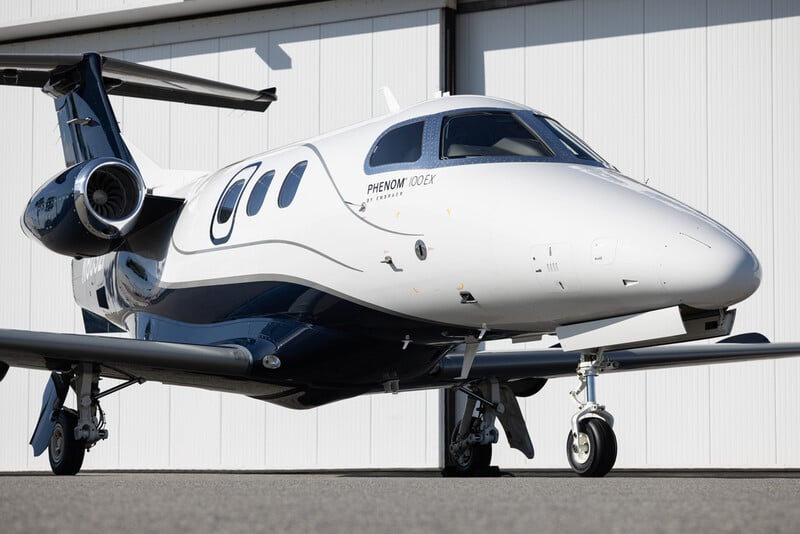We don’t need to tell you that flying privately is a time machine. You can use more convenient airports and schedule flights to leave when you want. Jet cards with guaranteed availability and fixed or capped rates are an easy way to access private aviation, as you can book your flight in minutes. Most jet cards and memberships also give you a grace period if you are late, at no additional charge.
What’s more, quite a few programs allow you to upgrade or downgrade the size of your aircraft based on needs, which gets us to this article. Does it make a difference if your program guarantees an aircraft category versus a specific aircraft type?

Two Ways To Pick a Private Plane
In terms of jet cards and memberships, aircraft are offered in two distinct ways. One is by specific aircraft type, such as the Embraer Phenom 300, and the other is by category, such as light jet; although a few programs offer a bit of both.
For example, Nicholas Air, the 10th-largest operator in the U.S., has a program that offers access to different aircraft in its fleet. They include Embraer’s Phenom 100—a very light jet—and Textron’s Citation CJ3 and Embraer’s Phenom 300—both light jets. Since it doesn’t have a midsize jet, Nicholas skips up to Citation’s Latitude and Bombardier’s Challenger 300—both super midsize jets—and then the Gulfstream G600, a large cabin jet.
On the other hand, Sentient Jet offers category access. It provides light jets, midsize jets, super-midsize aircraft, and large cabin private jets.
Some category programs also offer turboprops, very light jets, and ultra long-range jets as categories, although the quartet of planes that Sentient gives are the standard.
Navigating Category Options
With category options, the provider is contractually obligated to find you a jet in that category. Yet within each category, there are dozens of qualifying aircraft types, each with differing cabin dimensions, seat layouts, luggage capacity, and range.
Each option has its own hourly rate, and there is a guaranteed minimum number of seats for each option, category, or aircraft type. Most light jet category programs, for instance, guarantee at least six passenger seats in the cabin.
Back to Nicholas Air: Their light jets, the CJ3 and Phenom 800, are configured to provide seven and eight seats, respectively. Another Phenom 300 or CJ3 operator may only guarantee six seats, as the jet’s owner can opt for varying layouts. Volato, which offers a HondaJet card program, has both four- and five-seat versions, but its program guarantees only four seats.

So beyond the number of passengers, you need to decide if you prefer variety or want a specific aircraft type. You’ll often find lower prices for category programs than for specific aircraft types, as aircraft-specific programs generally feature newer models.
Flyers also like category programs, as they give them a chance to sample different flavors of jet types. Jet cards are often a stop between one’s first experience with private aviation, which starts with a few charter flights, and the journey to fractional or full ownership.
However, if you have specific needs or preferences, you may be better off with an aircraft-specific option.
Benefits of Aircraft Type Programs
Being able to select a specific aircraft can sometimes save you money. For instance, most category-based card sellers guarantee only six seats on light jets and seven seats for midsize jets, although some offer an eight-seat guarantee.
That means if you are flying eight people, assuming you can fit your luggage, and the aircraft has the range for your mission, being able to select Nicholas Air’s light-jet Phenom 300 with eight seats is likely a more cost-effective option than having to upgrade to a super-midsize jet to accommodate eight passengers, which other programs would require.
Another benefit of choosing a specific model: The Phenom 300, offered by Flexjet, NetJets, Magellan Jets, Airshare, and others, has a longer range than other light jets. Since programs generally require you to choose a nonstop-capable option or charge you extra for fuel stops, a more-expensive light jet like the Phenom 300 could be more cost-effective than jumping to a midsize category option if providers deem your mission to require such.
Another reason for wanting aircraft-specific options is the cabin experience. To fly coast-to-coast nonstop typically requires a super-midsize jet. However, like other categories, all jets are not created equal. The Citation X is a workhouse for these missions, but some find its cabin height—just five feet, eight inches—cramped for five hours.
Airshare, Flexjet, Fly Alliance, Magellan Jets, NetJets, Nicholas Air, and VistaJet are examples of programs that offer super midsize options with six-foot-high stand-up cabins.
So, if you don’t want to fly in a Citation X coast-to-coast, you would want to investigate an aircraft-specific program—again, noting that it will cost more than super midsize category options such as those offered by FlyExclusive and Wheels Up.
How to Decide on a Plan
At Private Jet Card Comparisons, we help members figure out what’s right for their needs by preparing a custom analysis, but you can get a head start. The best way to determine what is right for you is to plan your next year’s travel.
Where are you going to be flying? How many people will you be bringing on those flights? How much luggage? Will you be bringing pets? What type of cabin experience do you want? By furnishing this information to providers when you contact them, they can tell you which of their options best fit your needs.
As a final note: Depending on your flight profile, it may make sense to join more than one program. For each of your trip profiles, figure out which providers work best.










